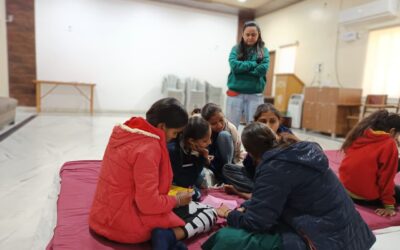A single story is one where the same thing gets told over and over again about a people or a place we do not know first-hand. The danger? It leads to stereotypes, to half-truths, not the truth.
Our lives and cultures are composed of many overlapping stories. A single story is the opposite of what Chinua Achebe calls “the balance of stories”, where people tell their own stories in their own words. Last month, I demystified amass of my single stories about villages in India. As a part of an exercise to know India at a micro level, we were asked to visit Motavida village in Udaipur. To start with, I had a lot of assumptions about the buses going to villages:
- Dirt, stench, chaos and lack of safety
- Grim faces staring at you
- Men deliberately brushing against women
- Plastic wrappers and bags lying around
These are a few visualizations I had at the mention of almost anything related to villages. As I boarded the bus from Udaipur, I realized I had accumulated many “half-truths”. Next, I got on an auto-rickshaw and as it stopped to pick more passengers, there was a farmer teaching farming to his two adolescent daughters. Both of them were trying to cut wheat from the ground while the father let them learn their own lessons.
Moving forward on a curvy road going uphill, I was audience to folded mountains, perfectly curved over the edges with trees standing over mounds in solitude, clear skies and wheat fields through the edges of the road. On reaching, Ghanshyam Ji (tuk-tuk driver) pointed to the Sarpanch’s house and the school. He may have assumed that I was there to discuss development goals or policies with the officials.

Scale of mountains and trees on Aravali.
I got down and start walking the roads that reached beyond the slopes to last set of houses. Hardly any lump of plastics hindered the view of plethoric mountains. I passed through orange cycles, boys in khaki school uniforms with distorted music playing on their radios and, a lady in pink picking up fodder for her buffaloes. All of them acknowledged and returned my gesture of holding hands in a Namaste with wide welcoming smiles. Everything was in sync.
As it turns out, a picture is not worth thousand words. 3 out of every 7 photographs representing Indian villages show malnourished children with stern expressions, unavailability of water and lack of livelihood opportunities. Motavida bust all these. If you’d point camera at Ramesh, he’d try to sit straight and look conscious. But as I sketched his live portrait, he was free to breathe, connect, laugh and interact with his friends.

I have been told things like villagers always live in clusters and women always help other women to put water vessels on their heads. The ease of using the word ‘Always‘, and the problem is that it leads to misconceptions. Here, people live close to their farmlands and men also help women at hand-pumps with vessels. They were humble and welcoming, contrasting to my thought of them being nosy and complaining. I have always been afraid of being exploited or looted in rural/remote areas but this hamlet gave balance to my stories about safety and security in villages.

A seasonal migrant labor, building a wall for his farms in the village.
While I was leaving to visit another village in Gogunda, Udaipur thinking that I’ve seen enough for the day, there was a tribal woman buying beer at the ‘English Bar‘ counter. It came as a pleasant shock and broke the monotony in my head. On reflecting back, I realized that often our single stories are not rational as we cage our thoughts and stop looking beyond them.
Featured image by Ayushi Shukla, 2018 cohort India Fellow
Graphics and sketches by the author




What a wonderful write – up! Very beautifully written and illustrated.
Thank you Niharika 🙂